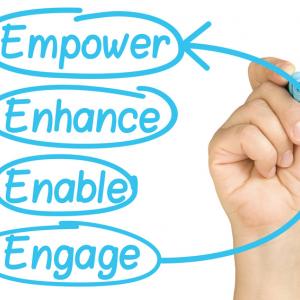Karen Keller
How does she do it? She walks into the room, and all eyes and ears are on her. Waiting, listening, watching. She is the one everyone recognizes as the leader when a team is formed. She's the first one picked by clients or customers to speak with about their multi-million dollar account. They look to her for guidance and courage.
What does that woman have that you don't? What's her secret? Presence.
Executive Presence.
The corporate culture has advanced a great deal in the past several years, but we are still guided by our primal instincts. Having a powerful, commanding presence is the "big stick" of the modern day woman in the executive suite.
Nothing can replace presence. The environment is simply a reflection of the energy we place out there – an energy that comes from within.
Why does this carry so much weight? Well, we don't walk around with our resume glued to our forehead announcing our talents and skills to the world. Since people don't "know" you, they are responding to and drawn to the physical energy you project. This is how people form an opinion of you in less than 3 seconds. This is your "visual resume."
Everything you say and do is evaluated on the basis of that 3-second opinion. It's not a question of whether this is right or wrong. It's simply a fact of life you learn to live with.
You are constantly scrutinized.
It's your executive presence that dictates how others will deal with you: the job interviewer, co-workers, bosses, boards of directors, and most importantly, your clients.
Being confident isn't a guarantee of presence; rather, it's how you express your confidence that makes an impression. It's your ability to project a sense of ease, poise, or self-assurance.
Executive presence is all wrapped up in how you look, how you smell, how your voice sounds, how you carry yourself, what words you are using, and what energy you send out.
There are three areas for you to focus on to create and build your executive presence.
The first area is your image. You first need to know what image you want to project. This image can change with the situation.
If you are trying to convince the CEO of your newest idea, you want to portray an image of intelligence, competence and confidence. You will want to exercise respect. Keep your ego out of it.
This is different from the image you want to portray of being the team leader. As the team leader, you'll need to be listening, encouraging, caring and thoughtful. You want to be seen as the go-to person.
The key is to choose and know which image fits the circumstance you're in. There are three components that make up your image: looks and presentation, voice and words, and body language.
The second area is your posture. Do you lean back in your chair during meetings? Are you shaking your leg under the table? Do you fidget in your chair? Keeping a tall, erect posture portrays a sign of self-confidence, which allows others to be confident in you. Information received from someone slouching, being restless or less than engaged is assumed to be incorrect.
When you present a posture of confidence, which is shoulders back, back straight and feet shoulder width apart in a grounded stance, people will trust you, subconsciously admire you and begin to agree with whatever you have to say.
The third area is your eye contact. There is truth in the saying, "The eyes are the windows to the soul." When you speak to clients or other executives, they search your face for your real intentions. The eyes are the fixture where they place emphasis. When you look into their eyes, you are giving them a sense of absolute certainty as to what you are saying.
Making solid, fearless eye contact draws people in to you, helping them to trust you and see you as an authority of whatever topic you are discussing. A strong powerful stare can help you stay in control of the situation more than any pointed statement you could make.
When you make direct eye contact, the message you are sending is that you are listening, interested, showing respect and concern that people will appreciate.
When you sense an argument or confrontation, look the other person straight in the eye focusing on the iris. Hold your stare with commitment that the other person will look away first. Be cautious of the "stare down;" use it only in certain circumstances.
You must always be aware of these three things without letting on that you are aware of them. Make sense? For instance, if you are getting ready for a meeting, you'll want to be in your best clothes, neatest hairstyle, and smell good. Will that cinch it for you? No. You need to project what you're wearing – your confidence, your commitment and your courage.
One final bonus area - be in control of your body movement. People can't read your mind, but they can read or react to your body language. Your body tells others what is going on in your head. This means you have to monitor your thoughts. Keeping yourself in a positive state of mind helps you move with freedom and confidence. Despite whatever pressures you face in the office, focus on positive thoughts.
Pay attention to your voice. When you meet someone for the first time, project your name and greeting. Be clear. Project the key points when making a presentation. Keep your words simple and easily understood.
You can't fake having a commanding executive presence; you can only move towards having it.
Having executive presence is the most important commodity an executive woman can have for her to have a meaningful existence. The key to having executive presence is the ability to project it.
[This is only one of the many powerful articles in this week's Influence It! Real Power for Women free ezine. To enjoy the full issue, jam packed with insightful information on strategies to enhance your personal and professional life to achieve ultimate success, you must be a subscriber. Sign up for your own free subscription NOW by clicking here!]



